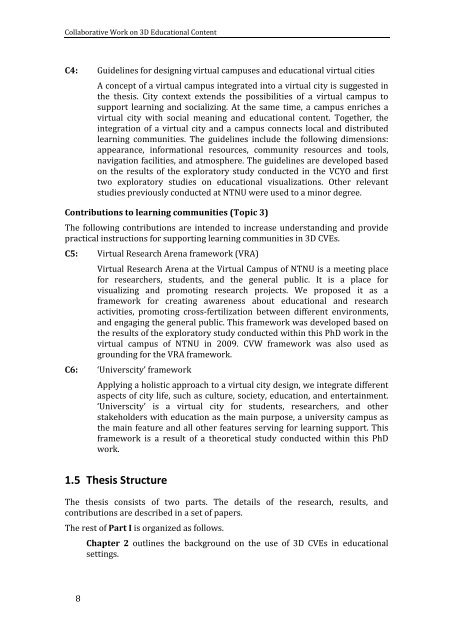Disputation Mikhail Fominykh - Department of Computer and ...
Disputation Mikhail Fominykh - Department of Computer and ...
Disputation Mikhail Fominykh - Department of Computer and ...
Create successful ePaper yourself
Turn your PDF publications into a flip-book with our unique Google optimized e-Paper software.
Collaborative Work on 3D Educational Content<br />
C4: Guidelines for designing virtual campuses <strong>and</strong> educational virtual cities<br />
A concept <strong>of</strong> a virtual campus integrated into a virtual city is suggested in<br />
the thesis. City context extends the possibilities <strong>of</strong> a virtual campus to<br />
support learning <strong>and</strong> socializing. At the same time, a campus enriches a<br />
virtual city with social meaning <strong>and</strong> educational content. Together, the<br />
integration <strong>of</strong> a virtual city <strong>and</strong> a campus connects local <strong>and</strong> distributed<br />
learning communities. The guidelines include the following dimensions:<br />
appearance, informational resources, community resources <strong>and</strong> tools,<br />
navigation facilities, <strong>and</strong> atmosphere. The guidelines are developed based<br />
on the results <strong>of</strong> the exploratory study conducted in the VCYO <strong>and</strong> first<br />
two exploratory studies on educational visualizations. Other relevant<br />
studies previously conducted at NTNU were used to a minor degree.<br />
Contributions to learning communities (Topic 3)<br />
The following contributions are intended to increase underst<strong>and</strong>ing <strong>and</strong> provide<br />
practical instructions for supporting learning communities in 3D CVEs.<br />
C5: Virtual Research Arena framework (VRA)<br />
Virtual Research Arena at the Virtual Campus <strong>of</strong> NTNU is a meeting place<br />
for researchers, students, <strong>and</strong> the general public. It is a place for<br />
visualizing <strong>and</strong> promoting research projects. We proposed it as a<br />
framework for creating awareness about educational <strong>and</strong> research<br />
activities, promoting cross-fertilization between different environments,<br />
<strong>and</strong> engaging the general public. This framework was developed based on<br />
the results <strong>of</strong> the exploratory study conducted within this PhD work in the<br />
virtual campus <strong>of</strong> NTNU in 2009. CVW framework was also used as<br />
grounding for the VRA framework.<br />
C6: ‘Universcity’ framework<br />
Applying a holistic approach to a virtual city design, we integrate different<br />
aspects <strong>of</strong> city life, such as culture, society, education, <strong>and</strong> entertainment.<br />
‘Universcity’ is a virtual city for students, researchers, <strong>and</strong> other<br />
stakeholders with education as the main purpose, a university campus as<br />
the main feature <strong>and</strong> all other features serving for learning support. This<br />
framework is a result <strong>of</strong> a theoretical study conducted within this PhD<br />
work.<br />
1.5 Thesis Structure<br />
The thesis consists <strong>of</strong> two parts. The details <strong>of</strong> the research, results, <strong>and</strong><br />
contributions are described in a set <strong>of</strong> papers.<br />
The rest <strong>of</strong> Part I is organized as follows.<br />
Chapter 2 outlines the background on the use <strong>of</strong> 3D CVEs in educational<br />
settings.<br />
8
















